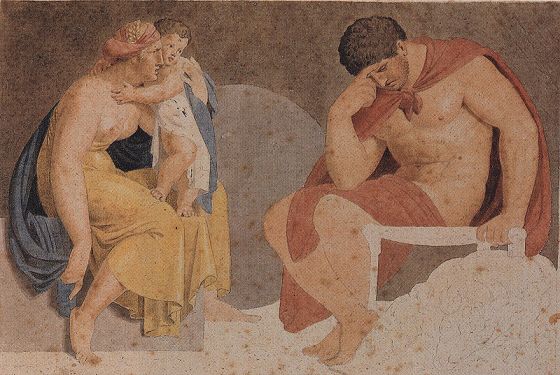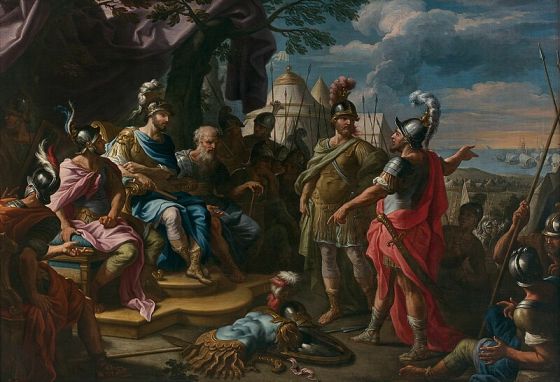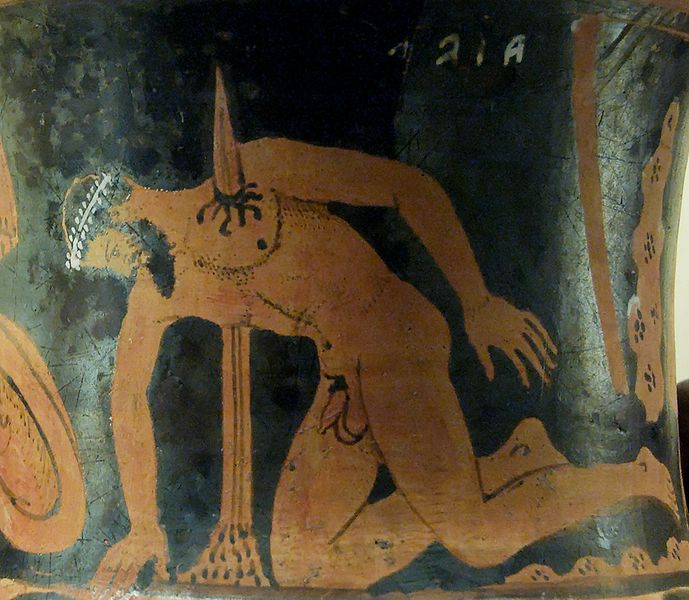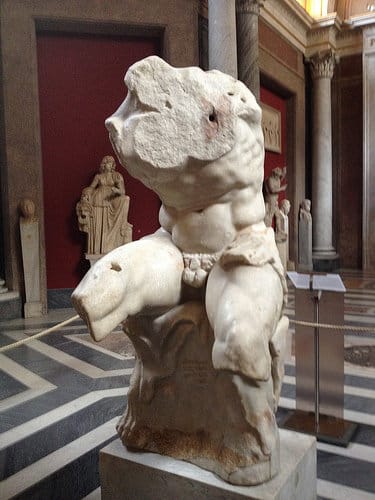When we think of Greek heroes, names like Achilles or Hercules might come to mind. But there’s another hero, equally formidable and deserving of admiration: Ajax the Great. This towering figure from the Trojan War era has tales that are both captivating and tragic.
Ajax the Great Key Facts
| Parents | Telamon and Periboea |
| Partners | Tecmessa |
| Siblings | Teucer |
| Offspring | Eurysaces |
| Other names | Aias |
| Roman name | Ajax |
| Best Known Myth | Duel with Hector & Suicide after Achilles’ armor dispute |
Name and Etymology
Ajax, or “Aias” in its original Greek form, is a name that has intrigued scholars and enthusiasts alike. Some theories suggest that it’s derived from the Greek word “aia,” meaning “earth” or “land.” This could be a nod to his grounded nature or perhaps his towering stature, making him seem as unmovable as the earth itself. The Romans, with their penchant for Greek tales, adopted him into their lore, retaining the name “Ajax.”
However, it’s essential to note that there were two figures named Ajax in Greek mythology: Ajax the Great and Ajax the Lesser. While both played roles in the Trojan War, they had distinct stories and backgrounds. Ajax the Great, the son of Telamon, was the prince of Salamis and stood out due to his immense size and strength. On the other hand, Ajax the Lesser, son of Oileus, was the king of Locris and was known for his speed and agility. Their shared name has often led to confusion, but their tales and deeds set them apart.
Throughout history, people have frequently associated both Ajaxes with various epithets and alternative names that highlight distinct facets of their personalities and actions. For instance, to differentiate between the two, they often used epithets tied to their fathers or birthplaces, like “Ajax, son of Telamon” or “Ajax of Locris.”
Ajax the Great Family and Relationships

Ajax was born to Telamon, the King of Salamis, and Periboea. He had a half-brother named Teucer, a renowned archer. Legends whisper of omens that marked his birth, signaling the arrival of a warrior who would achieve great deeds.
As he grew, Ajax formed deep bonds with many, but none as profound as his love for Tecmessa, with whom he had a son, Eurysaces. Beyond romantic relationships, Ajax also had a unique bond with Achilles, a friendship that would play a pivotal role in his life’s most tragic moments.
Myths about Ajax
The myths surrounding Ajax the Great are as captivating as they are tragic. His tales from the Trojan War era not only highlight his valor but also his vulnerabilities, giving us a holistic view of this legendary hero.
Duel with Hector
The duel between Ajax the Great and Hector stands as one of the most iconic moments in the annals of Greek mythology. Set against the backdrop of the Trojan War, these two colossal warriors met on the battlefield, representing their respective sides. Ajax, with his towering stature and immense shield, clashed with Hector, Troy’s mightiest champion.
Their battle was fierce, with neither giving an inch. The earth seemed to tremble with each blow they exchanged. Yet, after a day of intense combat, neither could claim victory. In a testament to the honor and respect shared between warriors, they parted ways by exchanging gifts. Ajax received a magnificent sword from Hector, while Hector was gifted a radiant belt by Ajax. This encounter showcased not just their prowess but also the mutual admiration they held for each other.
Dispute over Achilles’ Armor

Following the tragic death of Achilles, a contentious issue arose: who should inherit the legendary warrior’s divine armor? Ajax believed he was the rightful heir, given his close bond with Achilles and his contributions in the war. However, Odysseus, with his eloquence and wit, also laid claim. The two presented their cases before the Achaean leaders. The decision, unfortunately for Ajax, favored Odysseus.
This judgment was a heavy blow to Ajax’s pride. He felt deeply wronged, believing that his contributions and sacrifices during the war were overlooked. The armor, crafted by the god Hephaestus, was not just a piece of equipment but a symbol of honor and valor. Being denied this honor pushed Ajax into a profound despair, setting the stage for one of the most heart-wrenching moments in his life.
Tragic End
The perceived dishonor of being denied Achilles’ armor weighed heavily on Ajax’s heart. Unable to reconcile with the decision and feeling betrayed by those he had fought alongside, Ajax’s mental state deteriorated rapidly. In a moment of overwhelming grief and anger, he plotted to exact revenge on the Achaean leaders.

However, the goddess Athena intervened, clouding his judgment and causing him to slaughter livestock, mistaking them for his intended targets. When he regained his senses and realized what he had done, the weight of shame was unbearable. In a meadow, using the very sword gifted to him by Hector, Ajax took his own life. His end was tragic, a stark reminder of the heavy toll that war, pride, and honor can exact on even the mightiest of heroes.
Depiction And Characteristics
Ajax was often depicted as a towering figure, a giant among men. His immense shield, made of seven ox hides, became a symbol of his indomitable spirit and strength. Beyond his physical prowess, Ajax was known for his unwavering loyalty and sense of duty. However, like many heroes, he had his flaws. His pride and sense of honor, while commendable, also led to his tragic end. Animals like the lion, representing courage and strength, are often associated with him, as are symbols like the massive shield.
Representations Of Ajax In Art

Ajax’s imposing figure and tragic tale have inspired countless artists throughout history. From ancient pottery showcasing his duel with Hector to Renaissance paintings capturing his despair, Ajax’s legacy in art is vast. One of the most renowned depictions is Exekias’s vase painting, which beautifully captures the moment Ajax prepares for his tragic end. His story, filled with heroism and heartbreak, continues to resonate, making him a favorite subject in various artistic mediums.
it’s Game Time!
Do you need a break from this heroic story? Play this game!
Mentions in Ancient Texts
Homer’s “Iliad”
Written around the 8th century BC, the “Iliad” by Homer is perhaps the most iconic text that mentions Ajax. Homer, best known for penning both the “Iliad” and the “Odyssey,” is considered one of the greatest epic poets of ancient Greece. In the “Iliad,” Ajax is portrayed as one of the bravest Achaean warriors, often standing as the bulwark against the Trojans. A notable quote from the epic reads:
“There stood Ajax, unmatched for his shield, yet a little behind the swift-footed Achilles.”
Sophocles’ “Ajax”
Sophocles, a playwright from the 5th century BC and best known for his tragic plays, wrote “Ajax.” This play delves deep into the hero’s despair following the dispute over Achilles’ armor. It’s a poignant exploration of honor, pride, and the human psyche. Sophocles, one of the three ancient Greek tragedians whose plays have survived, is best known for his Theban plays, including “Oedipus Rex.”
Ovid’s “Metamorphoses”
The Roman poet Ovid, who lived from 43 BC to 18 AD, included Ajax in his magnum opus “Metamorphoses.” Ovid, best known for this work, explored various myths and legends, transforming them into a continuous narrative. In “Metamorphoses,” the tale of Ajax’s rivalry with Ulysses (Odysseus) over Achilles’ armor and his subsequent demise is recounted with poetic flair.
Pindar’s Odes
Pindar, a lyrical poet from ancient Greece (c. 518 – c. 438 BC), often mentioned heroes and their deeds in his victory odes. While his works span various topics, Pindar is best known for celebrating athletic victories in the ancient Olympic Games. In one of his odes, he praises the valor and might of Ajax, referencing his unparalleled bravery during the Trojan War.
Through these texts, we get a multifaceted view of Ajax the Great, from his valorous deeds in the Trojan War to his tragic end. Each author, with their unique style and perspective, contributes to the rich tapestry of tales surrounding this legendary hero.
Frequently Asked Questions
Ajax felt deeply dishonored when he was denied Achilles’ armor, leading to his tragic end.
Hector of Troy was his primary adversary, but they shared mutual respect.
Yes, he had a son named Eurysaces with Tecmessa.
It was made of seven ox hides, symbolizing his immense strength and resilience.
No, but they shared a deep bond of friendship.
Heartbroken over not inheriting Achilles’ armor, he took his own life with Hector’s sword.
Featured Image Credit: Author: Alfred John ChurchIllustrator: John Flaxman, Public domain, via Wikimedia Commons
